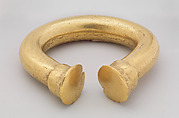Nose Ornament
Not on view
This nose ornament is a common form of metalwork made by Zenú people, who lived and live today in the Caribbean Lowlands of Colombia. The ornament is likely made of gold or an alloy of gold with copper, and was primarily created by lost-wax casting. (For more information on this process, please see Metropolitan Museum of Art 2008.569.13a, b). The object consists of a solid, curved bar with a circular cross-section, with two capped ends. Zenú ceramic figurines show people wearing such an ornament with the two ends pointing downward, in at least three cases by passing the ornament through the septum of the nose (Museo del Oro, Bogotá CS4272, CS4197, CS4195) and in at least one case apparently by balancing the ornament over the nose (Museo del Oro, Bogotá CS4270). Falchetti (1976, 81) notes that a ceramic funerary urn from the area of the Tapias River shows a person wearing a similar nose ornament, but with the "opening turning to one side." Other ceramic figurines of the Montelíbano Complex (see Falchetti 1995, pl. 57a,b) show people wearing these ornaments through the septum, with the ends downward, but also wearing them with other nose ornaments in the shape of half-moons. Jorge Robledo, a 16th-century Spanish colonist, reported seeing people wearing these nose ornaments, around Anserma, located in the Caldas department of Colombia (Falchetti 1976, 81).
In the case of the present example, the bar and caps were first formed in wax. The artists likely curved the bar into its present shape while producing the wax model—no hammering is evident on the bar to suggest it was curved after casting. There are traces of ceramic investment in the narrow spaces between the caps and the ends of the bar that would have been difficult to reach when the rest of the investment was removed. After the casting process, the artists likely hammered the caps in order to further shape them, forming the flared end that is present today. They also may have enriched the entire surface of the ornament in gold through a process like depletion gilding, in which a paste or solution of corrosive minerals is applied to the surface, reacting with the copper (Lechtman 1984; Scott 2014, 82). The object is then pickled to remove the copper compounds that form. On microscopic inspection of the cross section at the top edges of the caps, there appears to be gold enrichment at the outer edge when compared to the more interior metal. The faces of the two caps are especially smooth, suggesting that they were polished, removing traces of the hammering process.
This ornament belongs to the group defined by Ana María Falchetti (1995, 152, fig. 71a) as "nose ornaments in the shape of an ‘n’" ("narigueras en forma de ‘n’") and specifically Type 1a. Objects of this type show relatively high gold content and capped ends that curve inwards. There are variations within the larger group: in some cases, the ends are not capped, while in other cases, the ends show a braided design or several bands of metal (see Falchetti 1976, fig. 17; Falchetti 1995, fig. 71). The 55 objects of this type that Falchetti (1995, table 16) reports have a wide geographic distribution and are especially found in the areas of the Sinú, San Jorge, lower Cauca, and Nechí Rivers. A large group (16) was part of the context excavated near Ayapel, between the San Jorge and Cauca Rivers. The sizes of these 16 ornaments are variable, their weights ranging from 4.8 g to 64.5 g according to the records of the University of Pennsylvania Museum of Archaeology and Anthropology, Philadelphia, PA.
For further information on the context of Zenú metalwork, please see Metropolitan Museum of Art 1979.206.542.
Bryan Cockrell, Curatorial Fellow, Arts of Africa, Oceania, and the Americas, 2017
Related objects: 1977.187.13, 1979.206.541, 1979.206.542, 1979.206.1085, 2002.322.6
Further reading
Falchetti, Ana María. The Goldwork of the Sinu Region, Northern Colombia. MPhil diss., University of London, 1976.
———. El oro del Gran Zenú. Bogotá: Banco de la República, 1995.
Lechtman, Heather. "Andean Value Systems and the Development of Prehistoric Metallurgy." Technology and Culture 25 (1984): 1–36.
Scott, David A. "Metallography and Microstructure of Metallic Artifacts." In Archaeometallurgy in Global Perspective: Methods and Syntheses, edited by Benjamin W. Roberts and Christopher P. Thornton, 67–89. New York: Springer, 2014.
Due to rights restrictions, this image cannot be enlarged, viewed at full screen, or downloaded.

